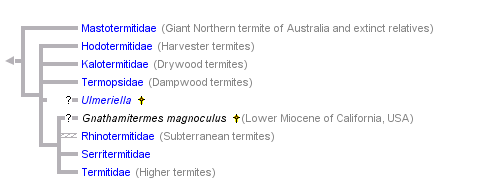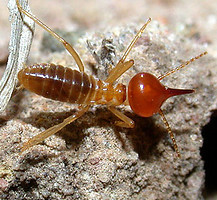Isoptera
Termites



This tree diagram shows the relationships between several groups of organisms.
The root of the current tree connects the organisms featured in this tree to their containing group and the rest of the Tree of Life. The basal branching point in the tree represents the ancestor of the other groups in the tree. This ancestor diversified over time into several descendent subgroups, which are represented as internal nodes and terminal taxa to the right.

You can click on the root to travel down the Tree of Life all the way to the root of all Life, and you can click on the names of descendent subgroups to travel up the Tree of Life all the way to individual species.
For more information on ToL tree formatting, please see Interpreting the Tree or Classification. To learn more about phylogenetic trees, please visit our Phylogenetic Biology pages.
close boxIntroduction
Feed on wood and other vegetable matter. Termitidae have symbiotic bacteria, other families have symbiotic flagellate protozoans that secrete enzymes that aid in the digestion of wood.
Characteristics
Derived characteristics:- eusocial, with reproductives, soldiers, and workers of both sexes.
- wings with basal sutures allowing them to be shed
- external genitalia rudimentary or lacking
References
Abe, T. D. E. Bignell, M. Higashi, eds. 2000. Termites: Evolution, Sociality, Symbiosis, Ecology. Kluwer Academic Publishing, Dordrecht.
Bitsch, C. and C. Noirot. 2002. Gut characters and phylogeny of the higher termites (Isoptera: Termitidae). A cladistic analysis. Annales de la Societe Entomologique de France 38(3): 201-210.
Breznak, J. A. and A. Brune. 1994. Role of microorganisms in the digestion of lignocellulose by termites. Annual Review of Entomology 39:453-487.
Carpenter, F. M. 1992. Superclass Hexapoda. Volumes 3 and 4 of Part R, Arthropoda 4 of Treatise on Invertebrate Paleontology. Boulder, Colorado, Geological Society of America.
Crosland, M. W. J., N. Y. Su and R. H. Scheffrahn. 2005. Arolia in termites (Isoptera): functional significance and evolutionary loss. Insectes Sociaux 52(1): 63-66.
da Cunha, H. F., J. A. F. Diniz, D. Brandao, and T. G. Myles. 2000. Intergeneric comparative analyses of ecological and behavioral traits of termitidae (Isoptera). Sociobiology 35(3):447-456.
Desalle, R., J. Gatesy, W. Wheeler, and D. Grimaldi. 1992. DNA sequences from a fossil termite in Oligo-Miocene amber and their phylogenetic implications. Science 257(5078):1933-1936.
Donovan, S. E., D. T. Jones, W. A. Sands and P. Eggleton. 2000. The morphological phylogenetics of termites (Isoptera). Biological Journal of the Linnean Society 70:467–513.
Eggleton, P. 1999. Termite species description rates and the state of termite taxonomy. Insectes Sociaux 46(1):1-5.
Eggleton, P. 2000. Global patterns of termite diversity. Pages 25-51 in: Termites: Evolution, Sociality, Symbioses, Ecology. T. Abe, D. E. Bignell, and M. Higashi, eds. Kluwer Academic Publishing, Dordrecht.
Eggleton, P. 2001. Termites and trees: a review of recent advances in termite phylogenetics. Insectes Sociaux 48:187-193.
Eggleton, P. and I. Tayasu. 2001. Feeding groups, lifetypes and the global ecology of termites. Ecological Research 16(5):941-960.
Eggleton, P., P. H. Williams, and K. J. Gaston. 1994. Explaining global termite diversity: productivity or history? Biodiversity and Conservation 3(4):318-330.
Emerson, A. E. 1952. The biogeography of termites. Bulletin of the American Museum of Natural History 99:217-225.
Emerson, A. E. 1955. Geographical origins and dispersions of termite genera. Fieldiana. Zoology 37:465-521.
Engel, M. and K. Krishna. 2004. Family-group names for termites (Isoptera). American Museum Novitates 3432:1-9.
Fontes, L. R. and M. Aparecida-Vulcano. 2004. Catalog of the fossil Isoptera of the New World. Sociobiology 44(2): 345-364.
Genise, J. F. and T. M. Bown. 1994. New trace fossils of termites (Insecta: Isoptera) from the late Eocene-early Miocene of Egypt, and the reconstruction of ancient isopteran social behavior. Ichnos 3:155-183.
Grandcolas, P. and C. D'Haese. 2002. The origin of a 'true' worker caste in termites: phylogenetic evidence is not decisive. Journal of Evolutionary Biology 15(5):885-888.
Grandcolas, P. and C. D'Haese. 2004. The origin of a 'true' worker caste in termites: mapping the real world on the phylogenetic tree. Journal of Evolutionary Biology 17(2): 461-463.
Grassé, P. P. 1982-1986. Termitologia. Vol. I: Anatomie Physilogie Reproduction, 676 pp.; Vol. II: Fondation des Sociétés Construction, 613 pp.; Vol. III: Comportement Socialité Écologie Évolution Systématique, 715 pp. Paris: Masson.
Grimaldi, D. and M. S. Engel. 2005. Evolution of the Insects. Cambridge University Press.
Harris, W. V. 1961. Termites: Their Recognition and Control. Longmans Group Ltd., London. 186 pp.
Howse, P. E. 1970. Termites: A Study in Social Behavior. Hutchinson Univ. Library, London, 150 pp.
Huang, F., S. Zhu, and G. Li. 1987. Effect of continental drift on phylogeny of termites. Zoological Research 8(1):55-60.
Huang, F., S. Zhu, and G. Li. 1988. The morphology of the termite (Isoptera) and its taxonomic system. Zoological Research 9(3):301-307.
Hunt, J. H. and C. A. Nalepa. 1994. Nourishment and Evolution in Insect Societies. Westview Press, Boulder, Colorado.
Inward, D. J. G., A. P. Vogler, and P. Eggleton. 2007. A comprehensive phylogenetic analysis of termites (Isoptera) illuminates key aspects of their evolutionary biology. Molecular Phylogenetics and Evolution. 44(3):953-967.
Jarzembowski, E. A. 1991. New insects from the Weald Clay of the Weald. Proceedings of the Geological Association 102(2):93-108.
Kambhampati, S. and P. Eggleton. 2000. Phylogenetics and Taxonomy. Pages 1-23 in: Termites: Evolution, Sociality, Symbioses, Ecology. T. Abe, D. E. Bignell, and M. Higashi, eds. Kluwer Academic Publishing, Dordrecht.
Kambhampati, S., K. M. Kjer, and B. L. Thorne. 1996. Phylogenetic relationship among termite families based on DNA sequence of mitochondrial 16S ribosomal RNA gene. Insect Molecular Biology 5(4):229-238.
Korb, J. and S. Katrantzis. 2004. Influence of environmental conditions on the expression of the sexual dispersal phenotype in a lower termite: implications for the evolution of workers in termites. Evolution and Development 6(5): 342-352.
Krishna, K. and F. M. Weesner. 1969-70. Biology of Termites, New York, 2 vols. Vol.I, 1969, 598 pp.; Vol.II, 1970, 643 pp.
Legendre, F., M. F. Whiting, C. Bordereau, E. M. Cancello, T. A. Evans. and P. Grandcolas. 2008. The phylogeny of termites (Dictyoptera: Isoptera) based on mitochondrial and nuclear markers: Implications for the evolution of the worker and pseudergate castes, and foraging behaviors. Molecular Phylogenetics and Evolution 48(2):615-627.
Lo, N. 2003. Molecular phylogenetics of Dictyoptera: insights into the evolution of termite eusociality and bacterial endosymbiosis in cockroaches. Entomologische Abhandlungen (Dresden) 61(2): 137-138.
Lo, N., O. Kitade, T. Miura, R. Constantino, and T. Matsumoto. 2004. Molecular phylogeny of the Rhinotermitidae. Insectes Sociaux 51(4): 365-371.
Lo, N., G. Tokuda, H. Watanabe, H. Rose, M. Slaytor, K. Maekawa, C. Bandi, and H. Noda. 2000. Evidence from multiple gene sequences indicates that termites evolved from wood-feeding cockroaches. Current Biology 10(13):801-804.
McKittrick, F. A. 1965. A contribution to the understanding of cockroach-termite affinities. Annals of the Entomological Society of America 58:18-22.
Nel, A. and J.-C. Paicheler. 1993. Les Isoptera fossiles. État actuel des connaissances, implications paléoécologiques et paléoclimatologiques. [Insecta, Dictyoptera]. Cahiers de Paléontologie, CNRS Editions, Paris.
Noirot, C. 1995. The gut of termites (Isoptera) - comparative anatomy, systematics, phylogeny. I. Lower Termites. Annales de la Société Entomologique de France 31(3):197-226.
Noirot, C. 1995. The sternal glands of termites: segmental pattern, phylogenetic implications. Insectes Sociaux 42(3):321-323.
Pearce, M. J. and B. S. Waite. 1994. A list of termite genera (Isoptera) with comments on taxonomic changes and regional distribution. Sociobiology 23(3):247-263.
Roisin, Y. 2001. Caste sex ratios, sex linkage, and reproductive strategies in termites. Insectes Sociaux 48:224-230.
Roonwal, M. L. and O. B. Chhotani. 1989. The Fauna of India and the Adjacent Countries: Isoptera (Termites). Volume I. Zoological Survey of India, Calcutta.
Roux, E. A. and J. Korb. 2004. Evolution of eusociality and the soldier caste in termites: a validation of the intrinsic benefit hypothesis. Journal of Evolutionary Biology 17(4): 869-875.
Shellman-Reeve, J. S. 1997. The spectrum of eusociality in termites. Pages 52-93 in Evolution of Social Behaviour in Insects and Arachnids. J. C. Choe and B. J. Crespi, eds. Cambridge University Press, Cambridge.
Schlüter, T. 1989. Neue Daten über harzkonservierte Arthropoden aus dem Cenomanium NW-Frankreichs. Documenta naturae 56:59-70.
Thompson, G. J., O. Kitade, N. Lo, and R. H. Crozier. 2000. Phylogenetic evidence for a single, ancestral origin of a 'true' worker caste in termites. Journal of Evolutionary Biology 13(6):869-881.
Thompson, G. J., O. Kitade, N. Lo, et al. 2004. On the origin of termite workers: weighing up the phylogenetic evidence. Journal of Evolutionary Biology 17(3): 720.
Thorne, B. L. 1990. A case for ancestral transfer of symbionts between cockroaches and termites. Proceedings of the Royal Society of London Series B 241(1300):37-41.
Thorne, B. L. 1991. Ancestral transfer of symbionts between cockroaches and termites: An alternative hypothesis. Proceedings of the Royal Society of London Series B 246(1317):191-196.
Thorne, B. L. 1996. Termite terminology. Sociobiology 28(3):253-263.
Thorne, B. L. 1997. Evolution of eusociality in termites. Annual Review of Ecology and Systematics 28:27-54.
Thorne, B. L. and J. M. Carpenter. 1992. Phylogeny of the Dictyoptera. Systematic Entomology 17(3):253-268.
Thorne, B. L., D. A. Grimaldi, and K. Krishna. 2000. Early fossil history of the termites. Pages 77-93 in: Termites: Evolution, Sociality, Symbioses, Ecology. T. Abe, D. E. Bignell, and M. Higashi, eds. Kluwer Academic Publishing, Dordrecht.
Watson, J. A. L. and H. M. Abbey. 1993. Atlas of Australian Termites. CSIRO, Division of Entomology, Canberra.
Weesner, F. M. 1965. The Termites of the United States. A Handbook. National Pest Control Association, Virginia.
Information on the Internet
- Online Termite Database. Taxonomic database of all living termites of the world. Reginaldo Constantino, Universidade de Brasilia.
- Termites at University of Toronto
- Dr. Don's Termite Pages.
- The Termites (Isoptera) of South Africa. A Catalogue of South African Insects.
- Isoptera. Termites. CSIRO, Australia.
- Fossil Isoptera.
- Termite Information. Texas A&M.
- National Termite Survey (U.S.). New Orleans Mosquito and Termite Control Board.
Title Illustrations

| Scientific Name | Zootermopsis nevadensis |
|---|---|
| Location | Northern Sierra Nevada, CA, USA |
| Comments | Dampwood termite |
| Specimen Condition | Live Specimen |
| Life Cycle Stage | Soldier |
| Copyright |
© 2004 Alex Wild

|
| Scientific Name | Reticulitermes sp. |
|---|---|
| Location | Northern California, USA |
| Comments | Subterranean termite workers and soldier |
| Specimen Condition | Live Specimen |
| Life Cycle Stage | Workers and a soldier |
| Copyright |
© 2005 Alex Wild

|
| Scientific Name | Trinervitermes sp. |
|---|---|
| Location | East London, South Africa |
| Specimen Condition | Live Specimen |
| Sex | Soldier |
| Copyright |
© 2003 Alex Wild

|
About This Page
Page copyright © 2003
 Page: Tree of Life
Isoptera. Termites.
The TEXT of this page is licensed under the
Creative Commons Attribution-NonCommercial License - Version 3.0. Note that images and other media
featured on this page are each governed by their own license, and they may or may not be available
for reuse. Click on an image or a media link to access the media data window, which provides the
relevant licensing information. For the general terms and conditions of ToL material reuse and
redistribution, please see the Tree of Life Copyright
Policies.
Page: Tree of Life
Isoptera. Termites.
The TEXT of this page is licensed under the
Creative Commons Attribution-NonCommercial License - Version 3.0. Note that images and other media
featured on this page are each governed by their own license, and they may or may not be available
for reuse. Click on an image or a media link to access the media data window, which provides the
relevant licensing information. For the general terms and conditions of ToL material reuse and
redistribution, please see the Tree of Life Copyright
Policies.
Citing this page:
Tree of Life Web Project. 2003. Isoptera. Termites. Version 01 January 2003 (temporary). http://tolweb.org/Isoptera/8212/2003.01.01 in The Tree of Life Web Project, http://tolweb.org/







 Go to quick links
Go to quick search
Go to navigation for this section of the ToL site
Go to detailed links for the ToL site
Go to quick links
Go to quick search
Go to navigation for this section of the ToL site
Go to detailed links for the ToL site